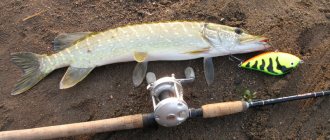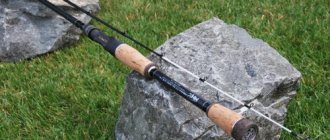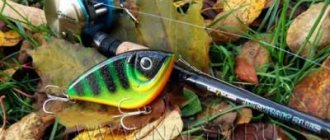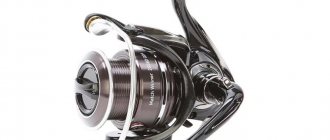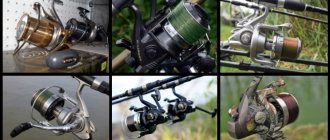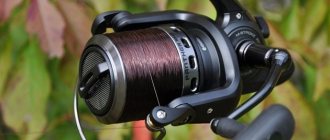In the operation of fishing reels, like any mechanism, one of the most important topics is LUBRICATION. I tried a lot in my time, collecting all the information on lubricants for inertia coils. I’ll tell you a little about my searches on this topic - it might be useful to someone. I already have a whole electronic library of this information on my computer. But none of this was really useful to me. You need to touch everything with your own hands and try it out while fishing. This is what I picked up as more or less useful attention for our brother spinning rod.
TOMFLON SK 170
(from -60°C to +170°C): High-temperature (frost-resistant) PTFE grease, specially developed as an alternative to CIATIM-221 grease. Possessing all the advantages of CIATIM-221 (good frost resistance and inertness towards all types of rubber and plastics), TOMFLON SK170 lubricant is characterized by better heat resistance, good mechanical stability and lack of hygroscopicity (does not absorb moisture (!!!)).
All the required parameters, but I don’t know the viscosity. These forgotten numbers don’t tell me anything. Further:
lubricant CIATIM-221F
is a fluorinated version of CIATIM-221 lubricant. Thanks to the introduction of ultrafine polytetrafluoroethylene (PTFE) into the CIATIM-221F lubricant, the extreme pressure and anti-wear properties of the lubricant are significantly improved, which increases the service life of bearings and other mechanisms by 3 or more times. In addition, CIATIM-221F grease is characterized by better heat resistance, good mechanical stability and lack of hygroscopicity (!!!!) (does not absorb moisture). It is especially effective to use CIATIM-221F grease in bearings in aggressive environments under increased or variable loads. In addition, thanks to the micron PTFE film formed on the surface of the friction pairs, noise and vibration are significantly reduced (!!!!!!). The operating temperature of CIATIM-221F lubricant is from - 60°C to + 160oC.
You could say it's ideal. The Shimano brand is resting. Russia rules. And the price is divine - not 800 hazel grouse. Here's another post from the fishing forum:
The Shimano brand is resting. Russia rules. And the price is divine - not 800 hazel grouse. Here's another post from the fishing forum:
"Silicone Grease SI-180".
«
Silicone oil PMS 200″, etc. Pros:
1) They cost 20-30 rubles per tube, which is enough for 3-4 lubricants. 2) There are thick and very thick and medium and liquid and completely liquid. For every taste. 3) Inert. They do not interact with plastics, rubber or other crap. 4) Operating temperature - from minus 50 to plus 150. I have been lubricating the coil for the third year now, at first - with constant monitoring of the lubrication and gears. In the ability not to be displaced from working surfaces and in the smoothness of the ride compared to the branded Shimanovskaya, I did not find any difference only in prices! An example of one of the industrial silicone lubricants purely for bearings. Not bad either, IMHO of course. :
Coil lubrication
The new season of spinning hunting has arrived, and as they say, a weapon should always be ready and should not fail at the most inopportune moment. In this topic I would like to discuss the nuances of lubrication of inertia-free and inertial spinning reels.
My budget Kaida reel has worn out in a couple or three seasons. Still, it’s not pleasant when, so to speak, while uniting with nature, you enjoy not the sounds of nature, but the disgusting creaking of an unlubricated coil. But creaking is not the worst thing - an unlubricated coil fails many times faster, this is especially not pleasant when you bought it for 100-200 Baku.
Today in Three Whales, for 30 wooden ones, I bought oil to lubricate the reels, or rather, to lubricate the bearings and rollers.
Naturally, this lubricant is not suitable for lubricating the worm gear of a reel. You need something thick there, like a CV joint.
Coil lubrication can be divided into six stages:
- External cleaning of the coil from contamination.
- Incomplete disassembly of the coil.
- Lubrication of reel mechanisms.
- Removing traces of grease from the reel body.
- Coil assembly.
- Checking the performance of the coil.
And so here is our patient:
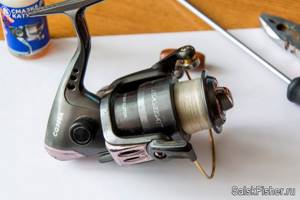
Before lubricating the coil, it must be thoroughly wiped with a rag to remove dirt, dust and sand. So that these foreign bodies do not get into the coil mechanisms and cause us even more trouble.
After this, we do not completely disassemble the coil, like a machine, in 15 seconds. to “excellent (joke)”:
- Unscrew the spool;
- Unscrew and remove the reel handle;
- Remove the coil rotor, unscrew the nut (Attention: the nut has a left-hand thread);
Of course, coils from different manufacturers may differ in design from each other, but the principle of operation is still the same for all.
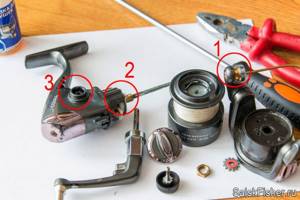
Once again we wipe all the parts and proceed directly to lubricating the coil. Please pay special attention to the line roller [1]. Very often, including in my case, with a long absence of lubrication, moisture, etc., the roller stops rotating properly and the fishing line or braid begins to literally cut it. So the first thing we do is lubricate it, and then check its performance.
Next, lubricate the bearing on the main shaft of the reel [2] and the bearings of the reel handle [3].
That's practically all. Now we wipe off all the oil drips and reassemble the coil in the reverse order. Once again we check its performance, as well as the absence of extraneous sounds.
From all this we can conclude:
Reel lubrication is one of the most necessary maintenance steps for inertia-free reels, which significantly extends their service life!
We express our views on this issue.
Silicone grease with Teflon for long-term operation. OKS 1148.
Silicone grease with Teflon (PTFE) for bearings that require low rotational resistance at the beginning of operation at low temperatures and which are further exposed to temperatures from +150C to 200C. Silicone grease with Teflon has excellent resistance to steam, animal, vegetable and mineral oils, as well as acid fumes. There are a huge number of silicone lubricants and from them you can choose one that is suitable for our reels in all respects and is inexpensive. I gave just one example above. Absolutely indifferent to water - the main plus. Well, etc.. Only one thing is not available - how they behave in the ball bearing of the line roller. Apparently they forgot to write in the annotations for lubricants. :)) You need to test it yourself...
There is also a CV joint, which is often mentioned in forums. But here’s a post I once came across in the same place: From faq to lubricants: CV joint 4-Lithium grease with a molybdenum disulfide content of at least 10%. Shelf life 5 years. MoS2 (molybdenum disulfide) is a very unique thing that holds enormous loads in the friction unit.
But only a naive person can pour molybdenum into his engine. After all, I missed the moment of changing the oil a little and the engine was in trouble. Why? Because the oxidation products of molybdenum disulfide consist of molybdenum oxide (MoO3), which is highly abrasive, and sulfur, a corrosive agent. This is very clearly visible when the boot on the CV joint breaks.
The CV joint fails, not because dirt got inside, but because disulfide decomposes under the influence of oxygen. Ingress of moisture aggravates the situation, as it produces sulfuric acid (H2SO4). Acid softens the metal, abrasive causes wear. That's it... And on the same subject, for general information and as a food for thought... On lubrication of coils and instructions for coils. According to the general rules, open-type bearings are filled with thick grease, not oil. Oil is used only as an additive for sealed bearings. And even then, it is not recommended to do this - the lubricant should be enough for the entire service life. Has anyone ever lubricated the bearings in a car with oil? Hard to imagine. And here is an almost open unit, accessible to water and everything in the world, rotating at speeds of up to 3000 rpm. per minute - and liquid oil. The accepted argument is ease of rotation. But let's take a car wheel as an example. What, it rotates heavily in weight? Yes, it can spin for five minutes! And the loads are heavier. And the lubricant is thick. In short, a reason to think about those who lubricate their rollers with thin oil... And special ones... Of course, they are essentially the best and right choice if you have them and you are confident in it. But I can’t imagine what’s so fancy and unusual about Shimano lubricant that costs 800 rubles for a meager tube. You can, of course, not take Shimano. It’s not like Shimana alone is alive with reels. There are also a variety of lubricants in the middle price range. But what kind of quality is there again? Personally, I trust our modern CIATIM more than some Malaysian packaging with the “correct” signature “fishing”.
Reel lubricant, which is better?
Liquid or thick lubricant for the line guide of the reel. Which is better? This article perfectly covers the topic of choosing a lubricant for a line guide reel.
Many fishermen do not even suspect how difficult the conditions of the line roller on spinning reels are. These are the loads created when wiring the tackle, playing fish, hooks transmitted to the roller through the fishing line, and a huge rotation speed (with conventional wiring - up to 2000 rpm, and on high-speed match reels - up to 10,000 rpm). In addition, the roller and bearing receive a fair amount of water and dirt, both from the fishing line during fishing and from the fisherman if handled carelessly (after all, this unit is quite difficult to make airtight).
Reel manufacturers generally solve the problem of protecting the line roller bearing: they install sealed ball bearings, additional washers (service and dirt-proof), and use a labyrinth seal system. However, even with very careful handling of the reel, the lubricant loses its properties over time and must be changed. Naturally, the question arises: should you use liquid or thick lubricant? On the one hand, the reel instructions in most cases recommend liquid oil. And indeed, what’s easier, without disassembling the assembly, drop a couple of drops into the gaps and, turning the roller, “disperse” the oil. But such lubricant is very quickly washed out by water and sprayed out under the action of centrifugal forces when the reel rotor and roller rotate. Even after the first fishing, the lubricant leaves only memories. Therefore, in my opinion, it makes sense to lubricate this unit with liquid lubricant only in field conditions, when there are doubts about the performance of the bearing, its cleanliness, or when the ball bearing is “singing.” True, this will not cure the latter, but maybe it will delay his death at least for a while. It is better to do this kind of work immediately after fishing. Before fishing, this is usually forgotten, and there is no need for old grease, water and dirt to stay in the unit for extra time.
In a quiet, homely environment, when it is possible to carefully disassemble the assembly and not lose anything, it makes sense to apply thick lubricant, counting on its long service life. Of course, the old lubricant should be completely removed by washing the parts in kerosene or solvent. It is better to choose a lubricant that is not quite thick, but semi-liquid (the consistency of store-bought sour cream) - it will lessen complicate the rotation of the roller and at the same time will very reliably protect the unit from the penetration of water and dirt. The grease can be applied in some excess - the excess is squeezed out at the first wiring and removed with a clean napkin or rag. And don’t forget: if the screw that holds the assembly together does not have a special notch against self-loosening, it should be seated with thread sealant. The recommendations presented are equally suitable for a roller on a friction bearing (bushing).
Share with your friends!


